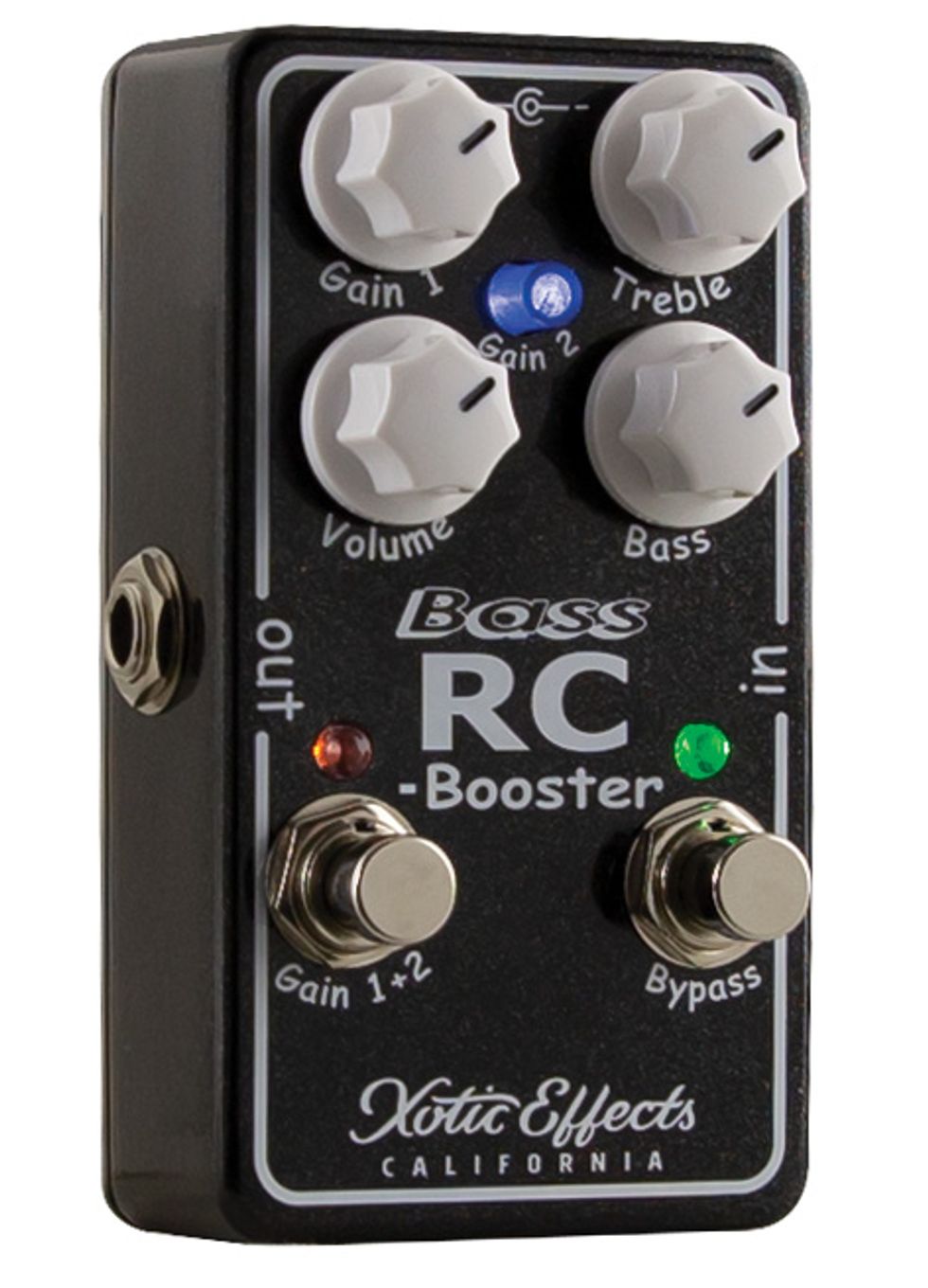Recorded direct to an Mbox and running with Logic X.
Clip 1: Fingerstyle with Sadowsky Vintage 5.
Disengaged until :17 when pedal is turned on with controls set flat.
Clip 2: Played with Yamaha BB2000.
Bass RC Booster with a bass boost at 2 o'clock placed in-line after distortion pedal.
0:00 - Clean
0:14 - With distortion only
0:26 - RC Booster engaged
Clip 3: Slap with Sadowsky Vintage 5.
Bass RC Booster’s bass and treble boosted to 2 o’clock.
0:00 - Bass RC Booster not engaged
0:12 - Bass RC Booster engaged
RatingsPros:Highly usable EQ. Quiet operation. Dual gain stages. Cons: Gain 2 control is somewhat difficult to get at/adjust. Street: $168 Xotic Bass RC Booster V2 xotic.us | Tones: Ease of Use: Build/Design: Value: |
Located just a 10-minute drive from where I’m writing this review, in the San Fernando Valley, California, Xotic has been in business for more than two decades. And the company introduced their first RC Booster pedal just a few short years after opening shop. It wouldn’t be an exaggeration to say the RC Booster is a staple among some guitarists, to such a degree that many have more than one on their pedalboards.
One of the functions our guitar-playing brethren use the pedal for, at the end of the chain, is to drive the input gain of their amps harder. This isn’t something I’ve necessarily felt I needed as a bassist, so what other functions could a pedal known for its versatility offer the low-end community? I was looking for the answer to this when I unboxed the new and improved version of the Bass RC Booster.
Classic Concept … New Face
The Bass RC Booster V2 feels robust and is fairly lightweight, at a touch more than a half-pound. The controls are an attractive vintage-cream-white color and have enough resistance to keep your settings safe from light, accidental touch. The new version of the pedal has two footswitches instead of its predecessor’s one. The right footswitch engages the pedal itself (gain stage number one), while the left footswitch engages both gain stages simultaneously.
The four main controls consist of gain 1 and volume on the left, and treble and bass on the right. The control for gain 2, which is much smaller and recessed, is located in the center of the quartet of white knobs. The benefit of this is that your set-it-and-forget-it position for the second boost is in a very safe place, out of the way of clumsy musician’s feet. That said, I had to use needle-nose pliers to adjust it so I wouldn’t unintentionally touch the settings of the neighboring main controls with my fingers.
Compared to the previous version of the pedal, the V2 is visually superior. And I extend props to the folks at Xotic for cramming a lot of functionality into a fairly small footprint. Depending on how much headroom a player wants, the Bass RC Booster can operate from 9V to 18V.
A Touch of Personality
For starters, I wanted to hear the pedal with no bump in volume or equalization. This is important for players wanting to use the RC mainly as a solo boost while retaining the exact characteristics of their original tone. Listening closely using headphones, it was clear that the Xotic indeed has a very subtle sonic thumbprint. I was using my 20-year old Sadowsky in passive mode, and the RC Booster dug out a small amount of midrange and helped my bass lose a little honk, which I liked. Without boosting any treble, the Xotic still adds a little something to the top end of the tone, which I would describe as a small amount of usable presence. So, simply turning the pedal on will undoubtedly place the bass guitar in a slightly more forward position in many mixes.
Distortion Compensation
I’ve noticed that my favorite distortion pedal, like many distortion pedals for bass, loses a little low-end when operating in higher gain settings. Naturally, I wanted to see how the RC Booster would function as a high-end, studio-level EQ, which it did with flying colors. With the pedal placed immediately after the distortion in my signal chain and the RC Booster’s bass control boosted at 2 o’clock, it put fat, believable low-end back into my tone. This feature alone makes the pedal highly usable and valuable.
Royal Crown EQ
Continuing with the Sadowsky, I was curious to see how the RC Booster would compare to the instrument’s onboard preamp when using almost identical settings. Again, the Xotic proved exceptionally musical when I dialed in both bass and treble to the 2 o’clock mark. The pedal’s top end made the four-month-old strings sound fresh and clear without adding the harshness that many active onboard bass preamps have. On the other side of the spectrum, the low-end boost made my sound bigger, but without making it muddier. It took me less than 10 seconds to dial in a to-die-for slap tone with the pedal’s simple but effective EQ.
The Verdict
When you consider its small footprint, studio-quality EQ, and two separate gain stages, the simple yet effective Xotic Bass RC Booster is a pedal that many bassists, including myself, might envision placing in the must-have category. The bass version of this popular pedal is indeed a subtle multi-purpose tool and works like a piece of clay to be molded into whatever a bassist needs.








![Rig Rundown: AFI [2025]](https://www.premierguitar.com/media-library/youtube.jpg?id=62064741&width=1245&height=700&quality=70&coordinates=0%2C0%2C0%2C0)












 Shop Scott's Rig
Shop Scott's Rig




![Rig Rundown: Russian Circles’ Mike Sullivan [2025]](https://www.premierguitar.com/media-library/youtube.jpg?id=62303631&width=1245&height=700&quality=70&coordinates=0%2C0%2C0%2C0)










































